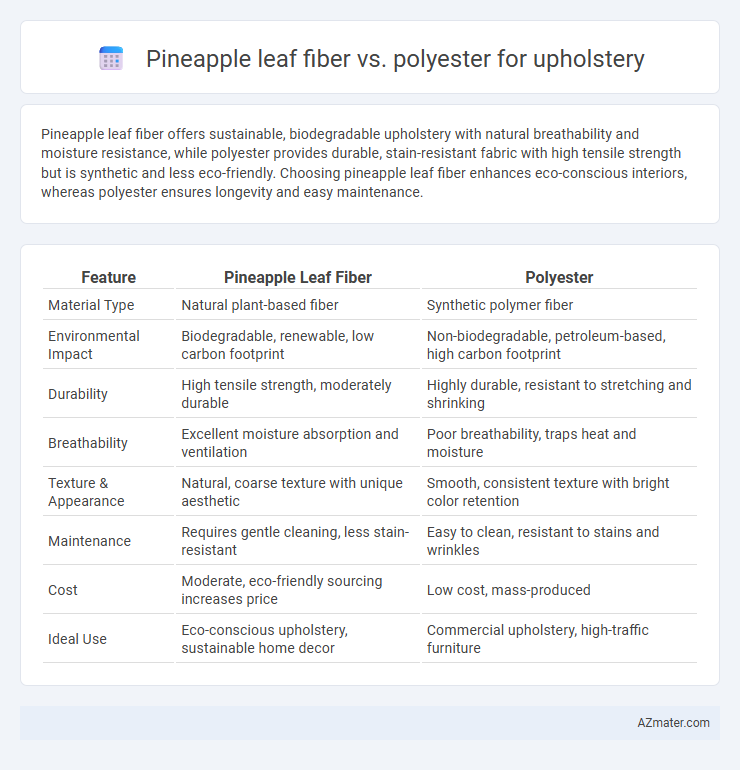Pineapple leaf fiber offers sustainable, biodegradable upholstery with natural breathability and moisture resistance, while polyester provides durable, stain-resistant fabric with high tensile strength but is synthetic and less eco-friendly. Choosing pineapple leaf fiber enhances eco-conscious interiors, whereas polyester ensures longevity and easy maintenance.
Table of Comparison
| Feature | Pineapple Leaf Fiber | Polyester |
|---|---|---|
| Material Type | Natural plant-based fiber | Synthetic polymer fiber |
| Environmental Impact | Biodegradable, renewable, low carbon footprint | Non-biodegradable, petroleum-based, high carbon footprint |
| Durability | High tensile strength, moderately durable | Highly durable, resistant to stretching and shrinking |
| Breathability | Excellent moisture absorption and ventilation | Poor breathability, traps heat and moisture |
| Texture & Appearance | Natural, coarse texture with unique aesthetic | Smooth, consistent texture with bright color retention |
| Maintenance | Requires gentle cleaning, less stain-resistant | Easy to clean, resistant to stains and wrinkles |
| Cost | Moderate, eco-friendly sourcing increases price | Low cost, mass-produced |
| Ideal Use | Eco-conscious upholstery, sustainable home decor | Commercial upholstery, high-traffic furniture |
Introduction to Upholstery Materials
Pineapple leaf fiber is a sustainable, biodegradable natural material known for its durability and breathability, making it an eco-friendly choice for upholstery. Polyester, a synthetic fiber derived from petrochemicals, offers high wrinkle resistance, color retention, and easy maintenance, commonly used in commercial and residential upholstery. Comparing pineapple leaf fiber and polyester highlights a trade-off between environmental impact and functional performance in upholstery materials.
What is Pineapple Leaf Fiber?
Pineapple leaf fiber is a sustainable natural textile derived from the leaves of the pineapple plant, renowned for its strength, biodegradability, and eco-friendly properties. Unlike polyester, which is a synthetic fiber made from petroleum-based polymers, pineapple leaf fiber offers breathability and a unique texture ideal for upholstery seeking an organic alternative. Its renewable sourcing and lower environmental impact make it a preferred choice in sustainable interior design applications.
Understanding Polyester in Upholstery
Polyester in upholstery is a synthetic fiber known for its durability, resistance to stains, and colorfastness, making it a popular choice for high-traffic furniture. Unlike pineapple leaf fiber, which is natural and biodegradable, polyester offers greater strength and wrinkle resistance but lacks eco-friendly properties. Understanding polyester's benefits and downsides helps in making informed decisions for upholstery needs balancing performance and sustainability concerns.
Environmental Impact: Pineapple Leaf Fiber vs Polyester
Pineapple leaf fiber boasts a significantly lower environmental footprint compared to polyester, as it is a natural, biodegradable material derived from agricultural waste, reducing landfill contributions and chemical pollution. Polyester, a synthetic fabric made from petroleum, involves energy-intensive production processes and contributes to microplastic pollution during use and disposal. Choosing pineapple leaf fiber for upholstery supports sustainable resource use and reduces carbon emissions, contrasting sharply with the environmental challenges tied to polyester manufacturing and degradation.
Durability and Strength Comparison
Pineapple leaf fiber offers natural tensile strength and biodegradability, making it a sustainable choice for upholstery with moderate durability. Polyester demonstrates superior resistance to wear, abrasion, and stretching, providing higher long-term durability and strength for heavy-use furniture applications. While pineapple leaf fiber is eco-friendly, polyester excels in maintaining structural integrity under frequent stress and impact.
Comfort and Aesthetics
Pineapple leaf fiber offers superior breathability and natural softness, enhancing comfort in upholstery compared to synthetic polyester, which can feel less breathable and sometimes stiff. Aesthetically, pineapple leaf fiber provides a unique, organic texture with subtle variations and a matte finish that complements eco-friendly or rustic interiors, while polyester typically delivers a smooth, uniform appearance with high colorfastness. Choosing pineapple leaf fiber supports sustainability and adds a tactile warmth that polyester upholstery often lacks.
Cost Analysis and Market Availability
Pineapple leaf fiber (PALF) offers a sustainable and biodegradable alternative to polyester in upholstery, with production costs generally higher due to manual extraction and limited industrial-scale processing. Polyester benefits from widespread market availability and lower material costs, driven by large-scale synthetic fiber manufacturing and mass distribution. Despite PALF's premium price, its growing demand in eco-friendly markets reflects increasing consumer willingness to invest in sustainable textiles despite less extensive supply chains.
Maintenance and Care Differences
Pineapple leaf fiber upholstery requires gentle cleaning with mild soap and water, avoiding harsh chemicals to maintain its natural texture and durability. Polyester upholstery is more resistant to stains and can be cleaned with a wider range of solutions, including machine washing or spot cleaning with synthetic detergents. Unlike polyester, pineapple leaf fiber may degrade faster when exposed to excessive moisture or direct sunlight, necessitating more delicate care routines.
Sustainability and Future Trends
Pineapple leaf fiber offers a sustainable alternative to polyester for upholstery, derived from agricultural waste and boasting biodegradable properties that reduce environmental impact. Polyester, a petroleum-based synthetic fiber, contributes to microplastic pollution and relies heavily on fossil fuels, posing significant ecological concerns. Future trends prioritize the adoption of natural fibers like pineapple leaf fiber in upholstery to meet increasing consumer demand for eco-friendly, renewable materials in interior design.
Conclusion: Choosing the Best Upholstery Material
Pineapple leaf fiber offers a sustainable and biodegradable alternative to conventional polyester, making it ideal for eco-conscious upholstery projects. Its natural breathability and durability provide comfort and longevity, contrasting with polyester's synthetic resilience and ease of maintenance. Selecting the best upholstery material ultimately depends on balancing environmental impact, usage demands, and aesthetic preferences.

Infographic: Pineapple leaf fiber vs Polyester for Upholstery
 azmater.com
azmater.com